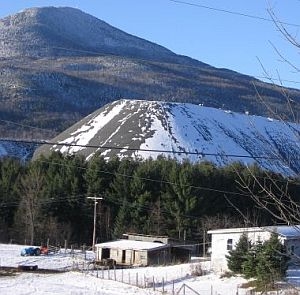 (Host) State environmental officials want to know whether asbestos waste from an abandoned mine was used for roads or construction projects in northern Vermont.
(Host) State environmental officials want to know whether asbestos waste from an abandoned mine was used for roads or construction projects in northern Vermont.
The state last week released a report that showed higher death rates from asbestos related diseases in the towns surrounding the mine.
The state wants to reduce exposure to the potentially dangerous mineral. So they’re asking the public for information about how the material was used.
VPR’s John Dillon reports
(Dillon) The mine on a remote mountainside in Lamoille County used to be the country’s largest source of asbestos.
Now it’s Vermont’s largest hazardous waste site.
A huge pile of rock tailings remains in Eden and Lowell. That’s the material left over after some of the asbestos was extracted. Some of the stuff has leaked into wetlands and has polluted the headwaters of the Missisquoi and Lamoille Rivers.
But officials are concerned about the public’s exposure as well.
Linda Elliott is with the waste management division at the Department of Environmental Conservation.
(Elliott) "What we’re looking for is to look to the public that are in the these communities just to see if they can remember historically that this tailing, this material, was used say for filling in driveways, for off-site properties. So we can at least start gaining a database."
(Dillon) The state has a document in its files that indicates the asbestos waste may have been used by local road crews and construction companies.
(Elliott) "The only piece of information we have is a letter back in the 70s that several of the local communities may have used this material. So we’re basically just trying to do an outreach, data gathering and then prioritize. If we do have the public coming forward we can prioritize and come up with a sampling plan."
(Dillon) Last week, the state Health Department released a study that showed a higher rate of two asbestos-related diseases in people who lived within 10 miles of the mine.
The report said that the odds of dying from asbestosis are more than 12 times as high among people living close to the mine compared to people living further away from the mine. The risk of developing lung cancer was also higher.
Health Commissioner Wendy Davis said that more study is needed. But she said the numbers on the cancer and disease rates were statistically significant.
(Davis) "And I think that is what was striking to us and what makes us think we must begin to be very seriously cautioning about avoiding exposure that they can avoid, so things like recreating on the mine site, we would really like to strongly caution people not to do that."
(Dillon) Linda Elliott of the state’s waste management division said that some of the waste rock contains very little of the dangerous fibers that cause the disease. She said the state needs to learn more about what tailings were used, and where. She said some of the material may have been spread on roads in the winter.
(Elliott) We just have anecdotal information that perhaps the local communities may have used this as a sand mixture, salt mixture for wintering … for icing, de-icing roads.
(Dillon) The state is meeting with the select boards in Lowell and Eden this week. Officials plan to hold public informational meetings in December.
For VPR News, I’m John Dillon in Montpelier.